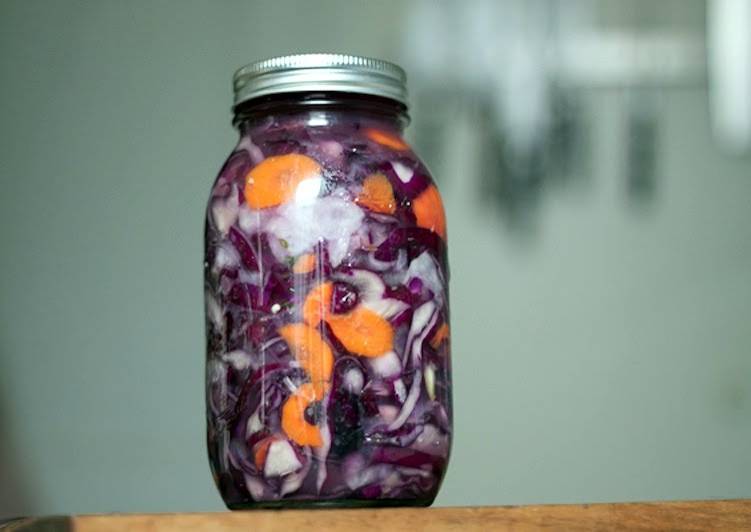
Whats up everybody, this time we will provide you with kimchi recipes of dishes which can be easy to know. We’ll share with you the recipes that you’re looking for. I’ve made it many occasions and it’s so delicious that you simply guys will love it.
Mak kimchi, or simple kimchi, is made with cut cabbage, radish, and scallions and a seasoned paste of red pepper, garlic, ginger, sugar, and fish sauce, salted shrimp, or kelp powder. (Image credit: Apartment Therapy ) Kimchi (/ ˈ k ɪ m tʃ iː /; Korean: 김치, romanized: gimchi, IPA: ), a staple in Korean cuisine, is a traditional side dish of salted and fermented vegetables, such as napa cabbage and Korean radish, made with a widely varying selection of seasonings including gochugaru (chili powder), spring onions, garlic, ginger, and jeotgal (salted seafood), etc. It is also used in a variety of soups. Get Kimchi Recipe from Food Network.
Kimchi is one of the most popular of recent trending meals in the world. It is easy, it’s fast, it tastes delicious. It is appreciated by millions every day. Kimchi is something that I’ve loved my entire life. They are nice and they look fantastic.
To get started with this particular recipe, we must first prepare a few ingredients. You can have kimchi using 7 ingredients and 19 steps. Here is how you cook it.
The ingredients needed to make Kimchi:
- Take 3 lb Red cabbage
- Take 3/4 lb Daikon radish
- Prepare 1/2 lb Yellow onion
- Get 5 to 10 cloves Garlic
- Get 1/2 lb Carrots
- Take 2 to 6 Thai Chilis
- Get 2 tbsp Kosher Salt or Sea Salt
You do need a large bowl and multiple containers. When you become confident, you can add radishes and turnips, but this is the basic formula, from a book on preserving, "Tart and Sweet" by Kelly Geary and Jessie Knadler. Kimchi is a traditional Korean dish made with salted, fermented vegetables. It typically contains cabbage and seasonings like sugar, salt, onions, garlic, ginger, and chili peppers.
Instructions to make Kimchi:
- Start by slicing the red cabbage in half, then quarters, so it'll be easier to work with.
- Slice all of the cabbage into strips about 1/4" thick. Put the cabbage into a bowl and set it aside.
- Slice all the daikon radish into thin coins. We slice everything super thinly to create as much surface area as possible! This will make it easier for the salt to do its work. The thicker it is, the longer it'll take to ferment.
- Add the radish to the same bowl as the cabbage.
- Trim and peel all of the onion. Thinly slice the onion and add it to the bowl.
- Peel all of the carrot.
- Now slice the carrot into thin coins and add it to the bowl.
- Peel 5-10 cloves of garlic, depending on how strong you like it, and smash the cloves.
- Add the garlic to the other vegetables in the bowl.
- Mince 2-6 Thai chilis into a fine paste. You'll start by cutting them into small slices then going over it all again with your knife to mince it even more finely.
- Add the chili to the bowl.
- It's time to mash those vegetables. Add 1/8 cup of salt (that's 2 tbsp) to the vegetables.
- Use your hands to squeeze and mash the vegetables and salt. Continue to do this until the vegetables start to leach water.
- Once water has leached out of the vegetables, set the bowl aside for 30 minutes. This will allow the salt to draw more water out of the vegetables. Clean up and relax!
- After the 30 minutes are up, tightly pack the vegetables into your 1 quart mason jar. Make sure there is enough liquid in the jar so that the vegetables are submerged.
- Put the lid on the jar and place it on your kitchen counter. Leave it at room temperature for at least 7 days. The bacteria need to be at room temperature to multiply and ferment.
- At least once a day, slowly open the lid to release the gases that build up. Hold your jar in the sink when doing this, for it’s sure to spray! Be sure to taste the ferment periodically. Once it tastes right to you, put it in your fridge.
- If the water level of the ferment drops below the vegetables, just add more of the mixture if you have any left over. If not, just add more water along with a pinch of salt, until the vegetables are submerged.
- Be sure to take a before and after picture of your kimchi. Watch it change color over time - it's a fascinating process. Post it on Twitter or Instagram with the hashtag #fermentfeast and we'll share it on the website.
Full of healthy, gut-healing probiotics, the benefits of eating kimchi are endless. This authentic kimchi recipe is vegan adaptable, gluten-free and can be made as spicy or as mild as you like! Kimchi is a true expression of the complexity of umami, that elusive savory fifth taste. It has a well-rounded, tempered heat from fresh ginger, garlic, and gochugaru set off by peppery Daikon radish. Fish sauce or salted shrimp paste brings a mouth-watering, pungent brine, and the cool crunch of fermented cabbage (or vegetable of your choice) rounds out the texture.
Above is the best way to prepare dinner kimchi, very simple to make. Do the cooking levels correctly, calm down and use your heart then your cooking will likely be scrumptious. There are many recipes that you could try from this website, please discover what you need. In the event you like this recipe please share it with your folks. Completely happy cooking.

